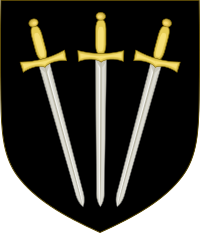|
Denys Rolle (died 1638)
 Denys Rolle (1614–1638) of Bicton and Stevenstone in Devon was Sheriff of Devon in 1636.[2] He was one of the biographer John Prince's Worthies of Devon. OriginsDenys Rolle was the second but only surviving son of Sir Henry Rolle (died 1617) of Stevenstone by his wife Anne Denys, a daughter and co-heiress of Thomas Denys of Bicton and Holcombe Burnell by his wife Anne Paulet, daughter of William Paulet, 3rd Marquess of Winchester (1532–1598).[3] His father pre-deceased his own father Sir Henry Rolle (1545–1625) of Stevenstone and thus Denys Rolle was heir to his grandfather. He was also heir to the large Denys estates of his mother, including Bicton. CareerRolle was according to most chroniclers a prodigy who died young at the age of 24 before his great potential was fulfilled. The Devon historian Tristram Risdon (died 1640) wrote of him:
John Prince (1643–1723) called him
Prince then relates an event in his life which illustrated his honourable disposition. Rolle loaned a large sum of money to Sir Bevil Grenville (1596–1643) in return for his written bond. Later when the two men were together in company, Rolle sent for the bond and threw it in the fire, stating that he had no need of a written bond and that
Marriage and issue Rolle married Margaret Poulett, daughter of John Poulett, 1st Baron Poulett (1585–1649) of Hinton St George in Somerset (a distant cousin of Paulet, Marquess of Winchester) by his wife Elizabeth Kenn (died 1663).[8][9][unreliable source] On 1 September 1637 an agreement of mutual maintenance was signed by Rolle and his father-in-law and Elizabeth, Countess of Essex (died 1656), (Elizabeth Poulet, daughter of Sir William Poulet of Edington, Wiltshire, past High Sheriff of Wiltshire and cousin of William Paulet, 4th Marquess of Winchester), second wife of Robert Devereux, 3rd Earl of Essex (1591–1646), whom she had married in 1630 and separated from in 1631. She remained at Essex House in The Strand, London, whilst Robert "played soldiers" on his estates.) and Thomas Smyth, husband of Florence Poulett, sister-in-law of Rolle and mother of Sir Hugh Smith, 1st Baronet, which committed all parties to share a household for a period of seven years, stating the sums of money to be committed by each party. Each year's residence was to be divided between Hinton St George (Poulett seat), Bicton (Rolle seat) and Ashton (Long Ashton, Somerset, seat of Thomas Smyth).[10] He had by his wife the following issue:[11]
Death and successionRolle was buried at Bicton on 13 June 1638.[16] His elaborate tomb monument[17] with heraldic achievement[18] is contained within the Rolle Mausoleum, the remnant of the former Parish Church of Bicton to the immediate east of which stands the new church of St Mary built in 1850. The Mausoleum is the private property of Lord Clinton and is not open to the public. The inscription on his monument was quoted by Swete and included a wish from his widow that their son should not die young.[19] His widow's wish as stated on the epitaph was not met and the couple's son Dennis died soon after his father, leaving only daughters who were excluded from the inheritance by entail. The manor of Bicton, together with all the other Rolle estates including Stevenstone then passed to Henry Rolle (1605–1647) of Beam, near Great Torrington, the elder son of John Rolle (1563–post 1628), MP, the uncle of Sir Henry Rolle (died 1617). He himself died without children and the Rolle estates, now increased by the addition of Beam, devolved following his death in 1647 upon his closest male cousin, 21-year-old Sir John Rolle (1626–1706), MP, of Marrais in the parish of St Mary Week, Cornwall. He was immediately thereupon married to his young cousin Florence Rolle of Bicton, one of the surviving daughters of Denys Rolle (died 1638). Thus his claim to the Inheritance of Rolle of Stevenstone and Bicton was strengthened and consolidated. Sources
References
|
||||||||||||||||||||||
